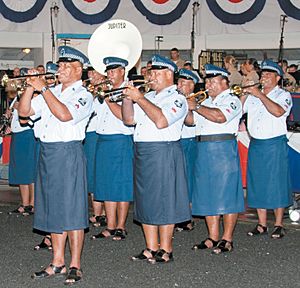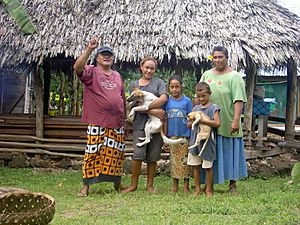Lavalava facts for kids
A lavalava is a special piece of clothing worn by people in Polynesia and other parts of Oceania. It's like a rectangular cloth that you wrap around your waist, similar to a skirt or kilt. The word lavalava means both one and many in the Samoan language.
Contents
Where People Wear Lavalavas
Today, lavalavas are still very popular in places like Samoa, American Samoa, Tonga, and parts of Melanesia and Micronesia. Both men and women wear them for many different reasons. You might see them as part of a school uniform or even as formal business clothes with a suit jacket and tie! Many people from Oceanic islands wear lavalavas to show their culture and because they are comfortable. This is true even for those living in other countries, like the United States (especially Hawaii and California), Australia, and New Zealand.
How to Wear a Lavalava
You tie a lavalava around your waist using a simple knot with the top corners of the cloth. Women often tuck the loose ends into the waistband. Men usually let the ends hang down in front. Women's lavalavas often reach their ankles, while men's usually go to their knees or mid-calf. The length can depend on what they are doing or the special event.
A Look Back: Lavalava History
Long ago, before Europeans came to the Pacific Ocean, the most special lavalavas were made from fine mats called 'ie toga. These mats were woven from pandanus leaves. Other lavalavas were made from siapo (tapa cloth), which came from the bark of trees like paper mulberry or wild hibiscus. Samoans also made beautiful lavalavas from natural things like flower petals, leaves, feathers, and seashells. These were tied onto a base made of woven plant fibers.
Later, materials like calico and cotton cloth became common. These new fabrics mostly replaced the older woven or barkcloth lavalavas for everyday wear. However, 'ie toga and siapo wraps are still used today for special ceremonies, celebrations, and dance performances.
Some Samoan men have a full body tattoo called pe'a, and women have leg tattoos called malu. When they dance or attend special events like 'ava ceremonies, they sometimes roll up the waistband or tuck in parts of their lavalava. This is done to show off their beautiful tattoos, and it's called agini.
Modern Lavalava Styles
Today, you can find special, tailored linen lavalavas that reach mid-calf. These often have pockets and ties or buckles. Men wear them for special events or to church. These formal lavalavas are always solid colors, unlike the bright patterns you see on everyday ones. They are known as sulu in Fiji, 'ie faitaga in Samoan, or tupenu in Tonga.
Samoan and Tongan women wear similar ankle-length skirts as part of their formal two-piece dresses. These are called puletasi in Samoa and puletaha in Tonga. For special occasions, the Tongan tupenu and puletaha are often worn with a tapa cloth or waist-mat called ta'ovala. Some Samoans still wear a tapa cloth vala sash in a similar way, especially for ceremonial outfits worn by speakers or dancers.
The idea for these formal, tailored linen lavalavas in Tonga, Samoa, and Fiji came from a Fijian leader named Ratu Sir Lala Sukuna. He brought the buckled sulu to Fiji in 1920 after his time in the military and studying in Europe.
Recently, lavalavas made from shiny materials like satin, velvet, polyester, and sequins have become popular. These are often worn by dance groups and choirs from villages, churches, or schools.
Other Names for Similar Clothes
In English, you might hear these types of clothes called a sarong. But sarong is actually a word from the Malay language, while lavalava is Samoan. Another common name for the Polynesian style is pāreu (often spelled pareo), which is the Tahitian name. In New Caledonia and Wallis and Futuna, lavalavas are called "manou". There's also a similar simple clothing called the lap-lap worn in Papua New Guinea and the South Pacific. This one is completely open on both sides.
Images for kids
-
A Samoan woman wearing a lavalava in Apia.
See also
 In Spanish: Lava-lava para niños
In Spanish: Lava-lava para niños




